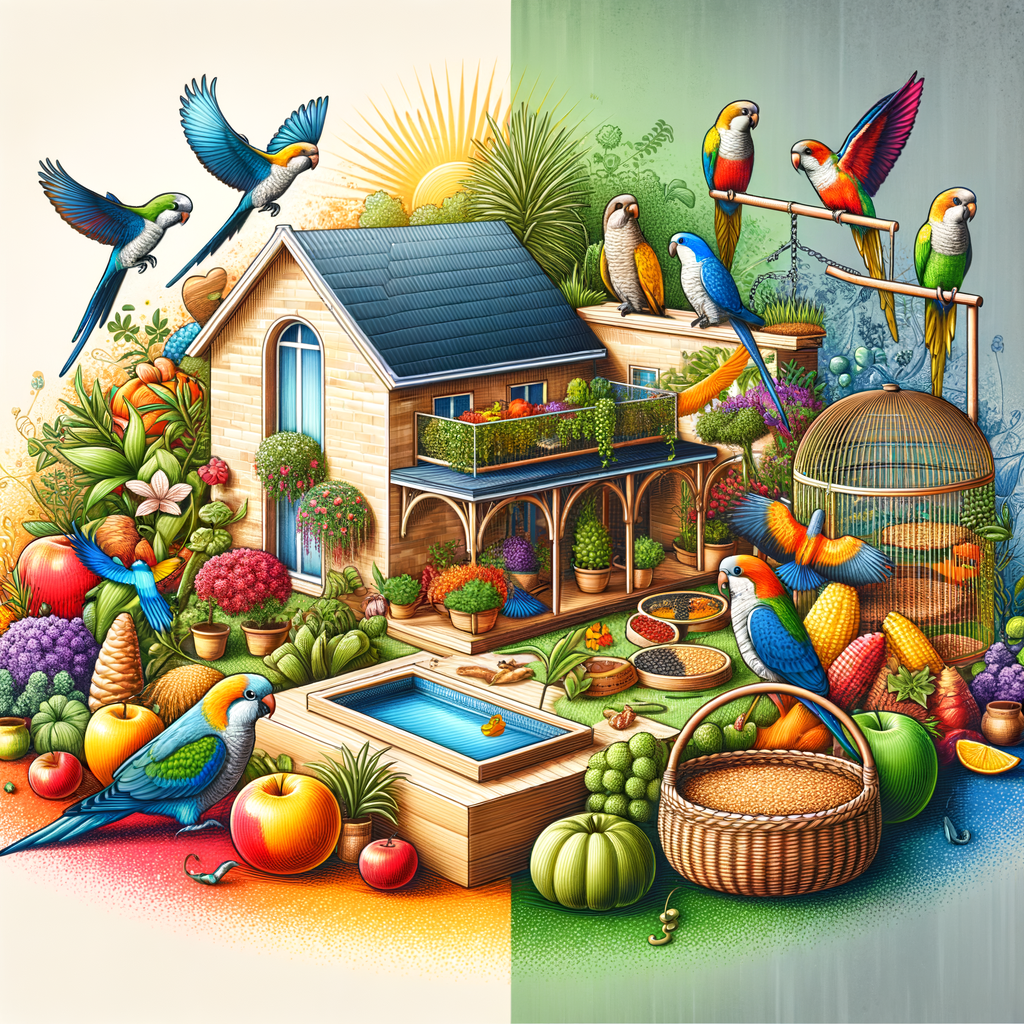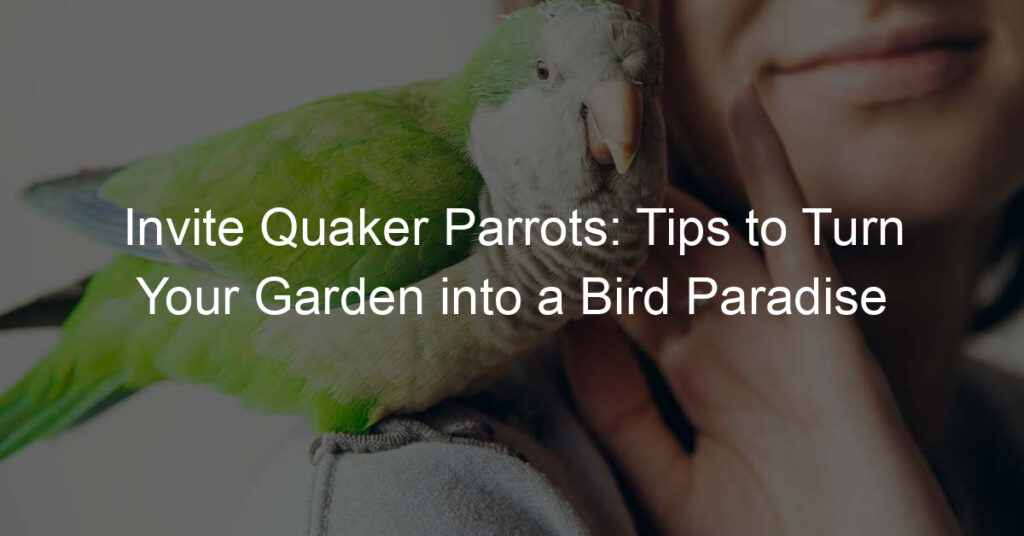
Introduction to Quaker Parrots
Quaker parrots, also known as Monk Parakeets, are a fascinating species of small parrots. They are known for their vibrant green color, playful nature, and unique ability to build nests. In this section, we will explore the world of Quaker parrots, their behavior, and their natural habitat.
-
Understanding Quaker Parrots
Quaker parrots are native to South America but have managed to establish colonies in North America and Europe. They are medium-sized parrots, measuring about 11 inches in length. Their bodies are predominantly green, with grey on their forehead and chest. Quaker parrots are known for their intelligence and social nature. They are also famous for their ability to mimic human speech, making them popular pets.
-
Quaker Parrot Behavior
Quaker parrots are highly social birds that live in large colonies in the wild. They are known for their loud calls and active behavior. Quaker parrots are also known for their ability to build complex nests with multiple chambers, a rare trait among parrots. In captivity, they require mental stimulation and social interaction. They can be trained to perform tricks and mimic sounds.
-
Quaker Parrot Habitat
In the wild, Quaker parrots are found in subtropical regions, where they build nests in trees. They prefer areas near water bodies, such as rivers and wetlands. In urban areas, they adapt to parks and green spaces. Quaker parrots have a diverse diet, including fruits, vegetables, seeds, and insects. In captivity, they thrive in spacious cages with plenty of toys for mental stimulation.
In the following sections, we will delve deeper into how you can attract these fascinating birds to your garden, how to care for them at home, and share a successful case study of Quaker parrot attraction. Stay tuned!
Attracting Quaker Parrots to Your Garden
Attracting Quaker parrots to your garden can be a rewarding experience. These vibrant, social birds are known for their playful nature and distinctive chatter. However, creating a suitable environment for them requires careful planning and consideration. Let’s explore how you can make your garden a welcoming home for Quaker parrots.
Creating a Suitable Environment
Creating a suitable environment for Quaker parrots involves two main aspects: providing appropriate nesting areas and ensuring a steady supply of their preferred food.
- Quaker Parrot Nesting
- Quaker Parrot Food
Quaker parrots, also known as Monk parakeets, are unique among parrots for their nest-building habits. Instead of nesting in tree cavities, they build large, complex nests with separate chambers for each pair. To attract these birds to your garden, consider installing a birdhouse or nesting box. Ensure it is placed high up, away from predators, and in a quiet area of the garden. The birdhouse should be sturdy, spacious, and have a small entrance to keep larger birds out.
Quaker parrots are primarily herbivores, and their diet in the wild consists of fruits, vegetables, seeds, and grains. In your garden, you can attract them by providing a bird feeder filled with a mix of seeds and grains. Fresh fruits and vegetables can also be offered. Remember to keep the feeding area clean to prevent the spread of diseases.
By providing suitable nesting and feeding options, you can make your garden a haven for Quaker parrots. Remember, the key to attracting these birds is to create a safe, comfortable, and food-rich environment that mimics their natural habitat.
Quaker Parrots in Garden: Do’s and Don’ts
When it comes to creating a welcoming environment for Quaker parrots in your garden, there are certain practices you should follow and others you should avoid. Here are some key do’s and don’ts to keep in mind.
- Do provide fresh water
- Don’t use pesticides
Quaker parrots, like all living creatures, need fresh water for survival. Not only do they drink it, but they also use it for bathing. Make sure to provide a clean, shallow dish of water in your garden. Refresh it daily to ensure it stays clean and free from harmful bacteria. This simple act can greatly increase the chances of attracting these beautiful birds to your garden.
Pesticides may keep unwanted insects at bay, but they can be extremely harmful to Quaker parrots. These chemicals can cause serious health issues and even death in birds. Instead of using pesticides, opt for natural methods of pest control. Planting bird-friendly plants that naturally repel insects can be a great alternative. Remember, a healthy garden is not only beneficial for the birds but also for the overall ecosystem.
In conclusion, attracting Quaker parrots to your garden involves more than just providing food and shelter. It requires a commitment to creating a safe and healthy environment for them. By following these do’s and don’ts, you can turn your garden into a paradise for Quaker parrots.
Quaker Parrots at Home: Care and Maintenance
Quaker parrots, also known as Monk Parakeets, are delightful companions that bring joy and vibrancy to any home. However, they require dedicated care and maintenance to ensure their health and happiness. Let’s delve into the specifics of Quaker parrot care, focusing on feeding and cleaning.
Quaker Parrot Care
Proper care for your Quaker parrot involves two main aspects: feeding and cleaning. Both are crucial for your pet’s wellbeing and longevity.
-
Feeding
Feeding your Quaker parrot a balanced diet is essential for their health. A diet consisting of 60-70% high-quality bird pellets and 30-40% fresh fruits, vegetables, and grains is recommended. Avoid feeding them avocado, chocolate, or any caffeinated or alcoholic beverages as these can be harmful to their health.
Food Type Percentage Bird Pellets 60-70% Fresh Fruits, Vegetables, and Grains 30-40% Remember, variety is key to a healthy diet. Try to introduce different fruits, vegetables, and grains into their diet regularly.
-
Cleaning
Keeping your Quaker parrot’s living environment clean is just as important as feeding them a balanced diet. Regularly clean their cage, removing any waste and uneaten food daily. Deep clean the cage once a week with bird-safe disinfectant, and ensure it is thoroughly rinsed and dried before your parrot returns.
Also, provide fresh water daily, and consider a bird bath or misting your parrot with water for their hygiene and enjoyment.
By following these guidelines, you’ll ensure your Quaker parrot is well-fed, clean, and happy. Remember, a well-cared-for parrot is a joyous addition to any home.
Quaker Parrot Training
Training your Quaker parrot can be a rewarding experience for both you and your feathered friend. It requires patience, consistency, and a lot of love. Here are two essential steps to help you get started:
- Step 1: Building Trust
- Step 2: Teaching Commands
Building trust is the first and most crucial step in training your Quaker parrot. Parrots are intelligent and sensitive creatures. They need to feel safe and comfortable with you before they can learn anything new. Spend time with your parrot every day. Talk to them in a calm and soothing voice. Offer them treats from your hand. This will help them associate you with positive experiences and build trust over time.
Once your parrot trusts you, you can start teaching them commands. Start with simple ones like “step up” or “come here”. Use a firm but gentle voice when giving commands. Always reward your parrot with a treat or praise when they follow a command correctly. This will encourage them to repeat the behavior in the future.
Remember, every parrot is unique. What works for one might not work for another. It’s important to be patient and persistent. With time and effort, your Quaker parrot will learn to trust you and follow your commands.
| Training Step | Description |
|---|---|
| Building Trust | Spending quality time with your parrot, talking in a soothing voice, and offering treats from your hand. |
| Teaching Commands | Starting with simple commands like “step up” or “come here”, using a firm but gentle voice, and rewarding correct behavior. |
Training your Quaker parrot can be a fun and rewarding experience. It strengthens the bond between you and your feathered friend and makes your time together more enjoyable. So, take your time, be patient, and enjoy the process.
Case Study: Successful Quaker Parrot Attraction
In this section, we will explore two case studies that demonstrate successful Quaker Parrot attraction. These real-life examples provide valuable insights and practical strategies for attracting these fascinating birds to your garden.
- Case Study 1: The Green Oasis
- Case Study 2: The Suburban Sanctuary
Located in the heart of a bustling city, the Green Oasis is a small urban garden that has become a haven for Quaker Parrots. The garden owner, Mr. Smith, started by planting native trees and shrubs that provide food and shelter for the parrots. He also installed bird feeders filled with seeds and fresh water sources.
Within a few months, Mr. Smith noticed an increase in the number of Quaker Parrots visiting his garden. He attributes his success to the combination of native plants and bird-friendly amenities. His garden is now a thriving ecosystem that supports a variety of bird species, with Quaker Parrots being the most frequent visitors.
The Suburban Sanctuary is a large backyard in a quiet suburban neighborhood. The owner, Mrs. Johnson, decided to attract Quaker Parrots by creating a bird-friendly environment. She started by removing potential hazards like toxic plants and loose wires. She then added birdhouses and feeders to provide safe nesting and feeding spots.
As a result, Mrs. Johnson has seen a significant increase in the number of Quaker Parrots visiting her backyard. She believes that providing a safe and welcoming environment is the key to attracting these birds. Her backyard is now a sanctuary for Quaker Parrots and other bird species.
These case studies demonstrate that with the right strategies and a commitment to creating a bird-friendly environment, you can successfully attract Quaker Parrots to your garden. Whether you have a small urban garden or a large suburban backyard, you can create a haven for these beautiful birds.
Key Takeaways: Turning Your Garden into a Quaker Parrot Paradise
After learning about Quaker parrots, their attraction to gardens, and their care and maintenance, it’s time to summarize the key points. Here are the two main takeaways that can help you transform your garden into a paradise for these vibrant birds.
- Creating a Quaker-Friendly Environment
- Proper Care and Maintenance
Quaker parrots are attracted to environments that mimic their natural habitats. Planting trees and shrubs that are native to their home regions, such as palm and eucalyptus, can make your garden more appealing. Additionally, providing bird feeders with their favorite foods, like fruits and seeds, can make your garden a go-to spot for these parrots. Remember to keep the environment safe and free from predators.
Once the Quaker parrots are attracted to your garden, it’s crucial to ensure their well-being. Regularly clean the bird feeders and water sources to prevent diseases. If you plan to keep them as pets, provide a spacious cage with toys for mental stimulation. Regular vet check-ups are also essential to monitor their health.
By following these key takeaways, you can create a welcoming environment for Quaker parrots in your garden. Not only will this provide a safe haven for these birds, but it will also add a splash of color and life to your outdoor space.
| Key Takeaways | Details |
|---|---|
| Creating a Quaker-Friendly Environment | Plant native trees, provide bird feeders with fruits and seeds, and ensure a safe environment. |
| Proper Care and Maintenance | Clean bird feeders and water sources regularly, provide a spacious cage with toys if kept as pets, and schedule regular vet check-ups. |








